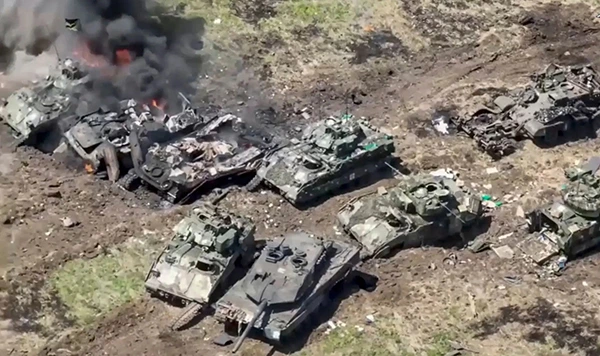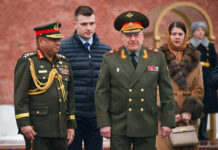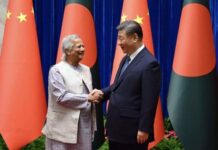
In terms of its sheer Intensity, duration and scale, the Russia-Ukraine War resembles some of the major battles of the First World War and more notably, of the closing phases of the Second World War. Some of the most cutting-edge weapons of our modern era have been put to the most unforgiving test of combat. The sheer scale of casualties in terms of personnel and even more, in equipment, have been colossal and unprecedented in recent times. Like in the two World Wars, artillery has again played a very dominant role. War-fighting is back to the era of Carl von Clausewitz – a brutal test of wills between evenly matched opponents that is a now a clear test of endurance and national stamina. We are now clearly “into an era of grinding wars of attrition, with high number of casualties on both sides (and where) neither combatant appears ready to throw in the towel, (despite brutal punishment). The world is witnessing the sheer costs Russia is willing to endure to accomplish its objectives.”
The New Relevance of High-Tech and Mass
In the dynamic between offense and defence, between tank and anti-tank weapons, between aircraft and air defence (AD) systems, we have seen a new equilibrium that clearly favours defence over the offense. Tanks, the primary instruments of offense, have taken particularly heavy casualties and the sheer lethality of surface-to-air missiles (S-300, S-400/500) have forced Air Forces to stay away from battle areas and restrict sortie generation rates (to just 250-300 a day). These were over 1600 a day in Gulf War I, some 600/day in Yugoslavia and 460/day in the 1971 Bangladesh War). This is a new era of not just high-tech but high-tech and mass. Any armed forces that fail to cater for this new order of lethality and the consequent need for mass, will be making a fatal mistake. Given the scale of casualties, we will have to focus hard on force–preservation, re-constitution of badly battered units and quick replacement of casualties in all future wars. Towards that end, the Indian Army’s move to cut manpower by two lakhs is very inopportune and ill-timed.
Col Jhonson writes, “What we are witnessing is a pivotal moment in military history, the re-ascendence of defence as the decisive form of war. We had seen it in World War and then we saw the same dynamic re-assert itself again by the end of World War Two. The power of the offensive had been restored at the start of that war by the brilliant German doctrine of Blitzkrieg, (which had created a lethal combination of tanks and Stuka dive bombers), to restore mobility on the battlefield. By the end of World War Two, defensive fire power had caught up once again, defeated the German Blitzkrieg and made attrition supreme on the battlefield once more. Stalin had said correctly “Artillery is the God of War.” In Ukraine, we have simply re-learnt the lessons of World War I and II. That is why the Russians chose to go on the defensive in 2023 and have so far inflicted some 70,000 personnel casualties and destroyed almost 7000 armoured vehicles.
Unprecedented Battle Field Transparency
What has favoured the defender and made the task of the attacker even more difficult is the near total level of battle field transparency in Ukraine. The US satellites, UAVs, AWACs, JSTARS, etc, can pick up virtually every single tank, truck and even soldiers that move on the battlefield. Surprise in the attack has, thus, become virtually impossible to achieve. Concentrations can be picked up immediately and even intentions can be discerned through electronic surveillance of enemy communications. What has made Russia’s task even more difficult is the proxy nature of the war. Had it been a direct clash between US and Russia, the latter could have shot down US spy satellites, AWACS and even drones loitering in Poland or Romania. These are now totally safe from any Russian counter-action. In a direct clash the attacker can take prophylactic action to shoot holes in the sky over the projected area of the offensive by downing enemy satellites with ASAT missiles. The proxy nature of this war has kept the surveillance assets of US and NATO totally unmolested and free to snoop on Russia. The levels of battlefield transparency, thus, available to Ukraine have simply been unprecedented in the annals of warfare.
Return of the Stalemate
The new equivalence or equilibrium between defensive and offensive systems has led to brutal stalemates on the battlefields of Ukraine and unprecedented levels of attrition that are reminiscent of the First World War and its sheer carnage. Once again, as in the two World Wars, medium and heavy artillery has proved to be a decisive, war-winning factor. An Austrian Army Operational Research Statistical Analysis (ORSA) study of the last seven years of combat in the Donbas region, has clearly highlighted that 45% of the tank kills, 65 % of artillery guns and 57 % of the vehicles destroyed were by medium artillery – especially of the 152/155 mm calibre.
Despite all the media hype, the total number of tanks destroyed by Anti Tank Guided Missiles (ATGMs) – Javelins, TOWs, etc, – were just 13%. A major media hype was created that Javelins, Stingers (and later the HIMARS) were singular war winning factors – the US silver bullets that by themselves would win the war single-handedly. There are no silver bullets in war. People said the tank was now a dinosaur – no longer relevant on the modern battlefield. As Capt Sir Basil Liddel Hart had noted earlier, the tank has been pronounced dead so many times in recent military history. Each time it reasserts its relevance. It is still the only viable instrument of shock and offensive action. So even though defence has regained primacy over offense in overall terms, the tank remains the sole instrument of offense on the land battlefields. Like at the end of World War II, tanks may have to be used in mass to overcome lethal defenses. Massive artillery barrages have to pave the way for tanks as we saw in the Donbas. We may need more tanks, not less. Top attack is a new vulnerability for tanks but it is certainly something that can and will be countered by simple expedients like canopies and more sophisticated Active Protection System (APS). Besides, despite all this media hype – actual casualties inflicted by the ATGMs on tanks have just been 13%. The real tank-killer was medium artillery (45% tank kills). As such, earlier lessons of the Second World War have simply been revalidated today.
Drones
Drones – unmanned aerial, ground and sea vehicles – have created a new revolution in military affairs (RMA). We have loitering Kamikaze drones that are able to inflict heavy casualties and yet cost so little. Drones are very useful for gaining tactical and contact intelligence and vector in artillery fire and air strikes and launch missiles and bombs. They have brought about a paradigm shift in the nature of war. The Russians have recently retrofitted Iranian Shahed drones with the Glonass navigation system and used them in mass to mask lethal attacks by their cruise and tactical ballistic missiles and saturate Ukrainians air defences.
Wrong Lessons from Low Intensity Conflicts
In fact, the world has learnt some patently incorrect lessons from the era of Low Intensity Conflicts (LIC). The levels of asymmetry between the opponents was inordinately high in Afghanistan, Libya, Lebanon and also in Iraq and even Yugoslavia and Syria. Due to the sheer asymmetry, patently wrong lessons were learnt which cannot withstand the shock of high intensity conflict between evenly matched opponents. No lessons from Afghanistan or Libya can be applied to any Western conflict with peer group competitors like China or Russia. Given the accuracy of precision guided munitions (PGMs), the levels of lethality have gone up by several orders of magnitude. What the Russia-Ukraine war clearly highlights is the need to graduate quickly beyond the era of LIC entailing inordinately high levels of asymmetry between the two sides. The world is rapidly entering into the era of long duration High Intensity Conflicts between evenly matched opponents, where the levels of attrition will be inordinately high.
Nuclear Backdrop
All such future conventional wars will be fought against a nuclear backdrop. So far, the nuclear threat had served to constrain the levels of combat below the nuclear threshold. However, we are increasingly seeing nuclear red lines being completely ignored on the modern conventional battlefield. So far, the USA and NATO have refrained from direct combat with Russia and China. Ukraine is an unfortunate proxy war that has been bled white. The Americans have certainly fought Russia to the last Ukrainian in the current conflict. Either by deliberate design or by sheer accident, the world is careening towards a dangerous Armageddon, a Third World War that may see limited or full-scale use of nuclear, biological and chemical (NBC) weapons. Restraints are fast eroding at a rate that spells serious danger for mankind.
An Economic War Coup de Grace?
In hind sight, it is quite apparent that the US and NATO (by the uncalled for eastward expansion of NATO) had deliberately pushed and provoked Russia into the Ukraine War. With some reflection (and purely in hindsight) it appears that a grand design of waging unrestricted economic war against Russia had already been prepared in the US. The aim was, perhaps, to repeat 1991 – when unrelenting economic war had caused the Soviet Union to collapse. That, however, had been the result of a carefully-calibrated, long term, economic war strategy to bring a nuclear power to its knees. It had been triggered by the American induced oil glut of 1986 in which the US had persuaded its surrogate – Saudi Arabia – to flood the world with cheap oil. In that year (1986) itself, petrol prices had plummeted from $30 a barrel to just around $10 a barrel. This unprecedented fall in oil prices had torpedoed and seriously wounded the Soviet economy. It went into a negative tailspin from which it never really recovered. In 1991, the USSR simply vanished without a shot being fired. The USSR splintered into 15 states and simply ceased to exist.
Was that the design that Joe Biden was trying to replicate? If so, the Second Economic War against Russia seems to have floundered rather badly till now. The outcome of this economic war will be far more consequential than the shooting war in Ukraine. At first the Russian Rouble had fallen rather steeply from 80 roubles to a dollar to over 160 roubles to a dollar. Russia, however, took strong and energetic counter measures. They asked for all payments of oil and gas to be made in roubles. Europe was hopelessly dependent upon Russian gas and oil. Creating alternative infrastructure would take minimum four to five years. Despite all brave talk of sanctions, Europe had no option but to keep buying Russian oil and gas on the sly. The cost of the war in Ukraine has been estimated at a billion dollars a day. It is noteworthy that Europe by itself has paid a billion dollars a day to Russia for its oil and gas and this has financed the Ukraine war for Russia.
Economic War and Europe. The Boomerang?
Europe, however, has been hit the hardest. Structurally its energy linkages with Russia were far too deep and comprehensive to be severed in such a hurry. The sudden removal of 3 million barrels a day of Russian oil has caused energy prices to skyrocket. From $70 a barrel they shot up to $125 a barrel. Russia and Ukraine are also the biggest exporters of food grains and sun flower oil. Energy inflation has now combined with food inflation to give a body blow to the global economy that was still reeling from the disastrous impact of the Covid pandemic. Today, the world is staring at a dangerous recession and stagflation. In hindsight, the economic war offensive against Russia has clearly boomeranged. What has clearly been destroyed beyond repair is the trust that was the basis of globalisation. America’s weaponsation of its banking system and economic institutions has destroyed this trust. Russia had a forex reserved $630 bn. Of this $300 billion was invested in US and European banks. America simply seized this money. Will Russia, China or India or other major economies ever put their money and trust in US banks again?
Impact on India
This military conflict is of overwhelming relevance to India. That is simply because over 70% of our cutting-edge military equipment is still of Russian origin. The Americans have tried to ridicule the performance of the Russian Army in Ukraine. It was not incompetence but a shift in the power of the defence over offense that has resulted in the stalemate. Had the US or NATO armies been attacking, they would have found the going as tough, if not tougher. This campaign is, therefore, being closely studied in all armed forces. Let me summarise some primary lesson in the Indian context:
Military Demographic. Demographics is the key to the outcome of any prolonged conflict. Russia has no shortage of equipment. It has a dire shortage of manpower and it is showing badly. Russia had fielded an Army of 1,50,000 against Ukraine, which has fielded some 2,50,000 (now almost 7,50,000 by some estimates) due to complete mobilization. The Russian constraints are painful and showing. It has had to recycle and use the same forces again and again. Due to embarrassing reverses in Kharkiev, Putin was finally forced, in Sep 2022, to order partial mobilization of 3,00,000 reservists. Had he done this at the outset the war would have been long over. He has now conscripted 2,70,000 fresh troops for his impending counter-offensive in winter. This has painful and obvious lessons for India. India has no dearth of manpower but it is cutting down its manpower and switching from a regular full ‘colour service’ Army to short terms inductees (Agniveers). Russian short term inductees (conscripts) have performed poorly in the Ukraine War. We need to draw immediate lessons from this war and take a fresh look at the Agniveer scheme. We may have to increase service tenures from 4 to 7 years and retention levels from 25% to 50%. Future wars will not just be high-tech but high-tech and mass. Seeing the grim realities of the modern battlefield we simply cannot afford to downsize.
The Tank is Dead. All notions that the tank has been turned into a dinosaur by drones, Javelins and TOWs is highly misplaced and premature. Tanks will continue to be the prime platform for offensive action for decades to come.
Medium Artillery. Artillery of the heavy and medium calibres has proved to be a decisive and war winning factor in the new wars of intense attrition. Artillery has inflicted 45% of the tank kills in Ukraine. Before the Kargil War, India had planned to standardize its Artillery around the 155mm caliber. The Bofors scandal badly derailed this plan. We now need to accelerate the mediumistaion of the Artillery with rapid induction of at least 1800 Advanced Towed Artillery Gun Systems (ATAGS) of indigenous manufacture at the earliest.
Air Power. Despite near total air superiority, the Russian use of air power was curiously restrained. Perhaps, this has been due to the vastly enhanced lethality of the AD systems (the S-300 and Buk SAMS and the shoulder-fired Stingers). Russian sortie generation rate at its peak was confined to 250-300 per day. In Gulf War I, the USAF was mounting 1600 sorties per day but against a much weaker and outdated air defence system of Iraq. India needs a 45-squadron Air Force to deal with the dual threat from China and Pakistan. Today, we are down to just 30. This is an alarming situation. We must accelerate our induction of fighters like Tejas and at least a 115 more in the Rafale class. Pending this, 155mm gun induction must be rapidly accelerated to make up for short falls in fire power. We may have to increase reliance on tactical ballistic and cruise missiles to much higher levels.
Drones. Drones have become the new war winning factor. Given their low cost the damage they can inflict on enemy tanks and equipment is formidable. They will have to be fielded in massive numbers.
Retrofitting Russian Tanks. Russian T-72 tanks make up 60% of India’s tank fleet. The war has shown ergonomic design flaws, wherein ammunition is stored in the turret which tends to blow up. We will have to retrofit these tanks with overhang compartments for ammunition stowage behind the turret.
Objectivity and ORSA. It is vital that this seminal conflict in Ukraine be studied dispassionately and objectively. There has been an unprecedented barrage of disinformation and propaganda. A military analyst must sift fact from fiction and discern the truth from post-truth. Only an objective (preferably ORSA-based) analysis will help in separating fact from fiction and draw up accurate lessons learnt. Over 3500 Tactical Ballistic Missiles (TBMs) to include Kinzhal hypersonic missiles, Iskandars and Cruise missiles (like Yakhont, Klub and Kalibir) were fired. We need to analyse their accuracy and impact on various types of targets.
Nuclear Backdrop. Another impact of overwhelming import is the nuclear backdrop. We find this aspect being recklessly ignored in the hope of snatching some limited advantage on the conventional battlefield. The nuclear threshold has proved to be rather elastic and flexible in the Ukraine War. Despite repeated Russian threats and nuclear sabre rattling, not a single nuke has been used so far. In fact no nuke has even been moved into firing position. What does that tell us about an India-Pakistan or an India-China war? Are nuclear weapons becoming an unusable resource? Or are we heading for an accidental or deliberate nuclear escalation that could prove to be catastrophic?

















